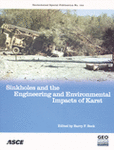Development and Evolution of Epikarst in Mid-Continent US Carbonates
Publication: Sinkholes and the Engineering and Environmental Impacts of Karst
Abstract
This paper presents the basic elements of a conceptual model for the development of epikarst in US mid-continent, horizontally-bedded carbonates in which flow is largely confined to secondary and tertiary porosity. The model considers the development of epikarst regimes in carbonate sequences beginning shortly after non-carbonate rocks are eroded away to expose the underlying carbonates and follows this through capture of the shallow flow by deeper dissolution conduits with reorientation of the epikarst to a more vertical form. The model does not require an underlying zone of vadose flow and in many cases considers development of such a zone to depend on the water supply provided by prior development of the epikarst. It is not claimed that all epikarsts form in the accordance with this model; rather this paper presents a viable additional model for epikarst formation under appropriate starting conditions. Factors influencing the development of epikarst are a combination of: 1) the pre-karst topography and modifications to this as the system evolves, 2) the original distribution and aperture of fractures as well as the distance and orientation of physically favorable fractures relative to potential discharge points, such as existing dissolutionally-enhanced channels with low head or nearby valleys, 3) character of soil cover as this affects percolation of water to the rock, erodability of the soil, sediment filling of conduits, and transport of sediment 4) variations in availability of dissolutionally aggressive water with time and location, and 5) low solubility layers, such as shale or chert, that promote lateral flow until a penetration point can be found. These interact to form an epikarst and deeper karst system that progressively increases its capacity both by internal improvement of its flow routes and extension into adjacent areas. The availability of water needed to promote dissolution also often has a positive feedback relationship to epikarst, in which locations of most active dissolution modify their vicinity to progressively increase capture of water, which promotes further dissolution. In early stages, lateral flow through the overlying soils and along top-of-rock must dominate the groundwater flow because the relatively intact carbonates have insufficient transmissivity to convey the available recharge through the body of the rock. Top-of-rock runnels developed by a combination of dissolution of their floors and piping erosion of their roofs would carry a significant portion of the flow. Horizontally-oriented epikarst develops with discharge to local drainage. Cutters and pinnacles, collapse-related macropores, and areas of concentrated recharge would begin to form at this stage. Initial downward propagation of this system would occur mostly due to lateral flow. Mixing corrosion could occur in sumps in these lateral flow routes when fresh, percolating rainwater mixes with older water with a higher dissolved load. Should conditions be suitable, leakage from this system promotes the migration of deeper karst conduits into the area by Ewers multi-tiered headward linking. Other sources of water may also bring in such deeper conduits. Once such deeper conduits are present, the epikarst can evolve into a more vertically oriented system, at least in the vicinity of master drains into this deeper system. Former shallow epikarst routes may then plug with sediment. In some areas, deeper systems may never develop due to unfavorable conditions. The epikarst may be the only significant system in these cases. This includes the case of poor karst formers such as interbedded shales and carbonates that may have very shallow horizontal epikarst flow paths that channel shallow subsurface flows.
Get full access to this chapter
View all available purchase options and get full access to this chapter.
Information & Authors
Information
Published In
Copyright
© 2005 American Society of Civil Engineers.
History
Published online: Apr 26, 2012
Authors
Metrics & Citations
Metrics
Citations
Download citation
If you have the appropriate software installed, you can download article citation data to the citation manager of your choice. Simply select your manager software from the list below and click Download.
